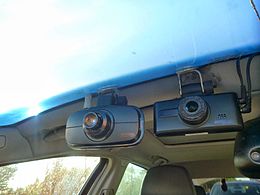Onboard camera
This articleneeds additional citations forverification.(February 2014) |

Anonboard cameraorin-car camerais a camera placed upon a moving object, such as a vehicle.
Inmotor racing,onboard cameras are often used to give a better perspective from the driver's point of view, whilst in films, these cameras are designed to increase the intensity and action of a specific scene. Onboard cameras were used in movies such asLe MansandThe Fast and the Furiousseries, for this purpose.
Much of the original development work which led to the onboard cameras used today was performed by Australia'sSeven Network,which introduced the technology at the1979 Hardie-Ferodo 1000endurance race atMount Panorama.
The original, Channel Seven, development team of John Porter and Peter Larsson moved to the states and formed Broadcast Sports Technology Inc.. BST then proceeded to recruit other staff from Channel Seven, notably Michael Katzmann.
American audiences were first introduced to RaceCam atNASCAR's1979 Daytona 500onCBSnetwork. The first live broadcast was on NBC in 1981 on Bill Alsup’s Team Penske Indy Car. BST also branched intoAmerica's Cupand Olympic sailing onboards.
The first time a live onboard camera was used in aFormula Onerace was at the1985 German Grand Prix,where one was attached toFrançois Hesnault'sRenault.Previously, cameras had only been mounted to F1 cars during testing, but since then, more and more cameras have been fitted. Since 1998, all Formula One cars have been fitted with at least three onboard cameras (usually more) and they form an integral part of thetelevision coverage.
As with US onboard coverage, F1 used a helicopter as a local satellite to pick up the transmission from the cars and re-broadcast it to the truck / local production center. This was initially shifted to a ground-based analog system, with variable results, and more recently to a ground-based digital solution which is now the norm. Onboard cameras are now commonplace in other top motorsports including theWorld Rally ChampionshipandMotoGP.
Dashcams
[edit]The use of dashboard cameras in automobiles began with law-enforcement in theUnited Statesin the 1980s and 1990s; then, as technology became cheaper, ubiquitous in civilian use in Russia as a form ofsousveillance,inasmuch as Russian courts prefer video evidence toeyewitness testimony,but also as a guard againstpolice corruptionandinsurance fraud.[1]
See also
[edit]References
[edit]External links
[edit]
